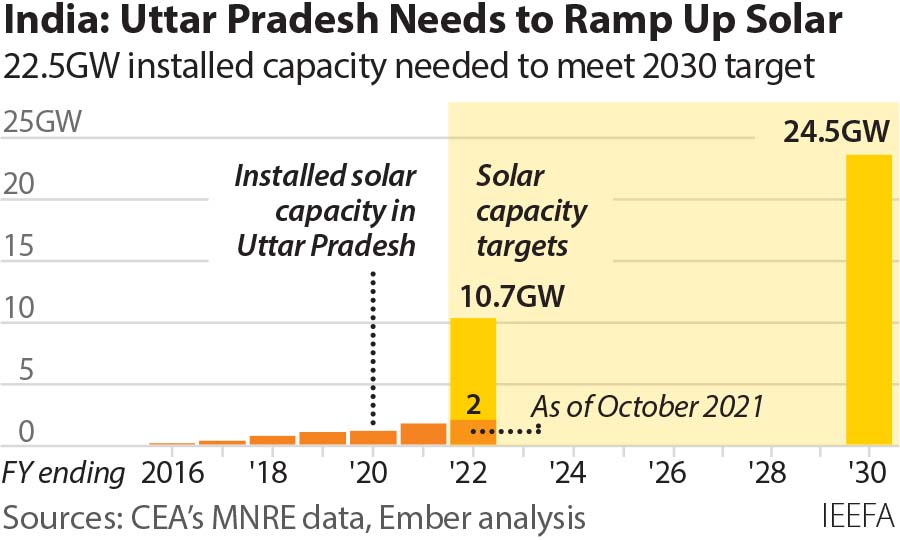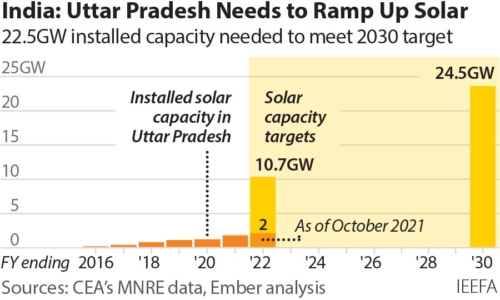IEEFA/Ember India: Uttar Pradesh is at a crossroads in its electricity transition

17 December (IEEFA/Ember, India): Uttar Pradesh has fallen behind other power-intensive Indian states in terms of delivering on renewable capacity targets.
A new joint report by the Institute for Energy Economics and Financial Analysis (IEEFA) and energy think tank Ember says urgent action is needed to get back on track, not only for the state to meet its own targets but also to avoid slowing overall progress towards India’s targets of 175 gigawatts (GW) of renewable capacity by 2022 and 500GW of non-fossil fuel capacity by 2030.
As of October 2021, Uttar Pradesh had total installed renewable capacity of 4.3GW, which is only 30% of its renewable capacity commissioning target of 14.1GW by 2022.
By comparison, other states with high electricity demand are well ahead on their 2022 capacity commissioning targets. Gujarat and Rajasthan have achieved 85% and 86% respectively, Tamil Nadu 72%, Maharashtra 47%, and Madhya Pradesh 45%.
The report finds Uttar Pradesh is tracking behind its peers on its 2022 solar capacity target of 10.7GW – the second largest solar target among all Indian states. Only about 2GW, or 19%, of that target has been achieved.
“Uttar Pradesh has a lot of catching up to do when it comes to rolling out solar capacity to meet its targets,” says report co-author Aditya Lolla, senior electricity policy analyst at Ember.

Uttar Pradesh accounts for a tenth of India’s power demand – the second largest share after Maharashtra. Over the past decade, the state’s electricity demand has increased by almost two-thirds and peak demand has more than doubled. And by 2030, electricity production is estimated to grow by 47 terawatt hours (TWh).
“Until now, Uttar Pradesh has met most of its strong demand growth with coal capacity expansion. Going forward, solar can fulfil the vast majority of future electricity demand growth if the state achieves its 23.5GW by 2030 target,” says Lolla.
“Hitting that target requires a major effort to ramp up solar capacity additions to around 2.5GW every year on average.”
Lolla and co-author, IEEFA energy finance analyst Kashish Shah, say Uttar Pradesh is now at a crossroads where the choices it makes about meeting future power demand growth could either speed up or slow down India’s decarbonisation journey.
Meeting its 2030 solar target will allow Uttar Pradesh to avoid locking in resources to build new coal plants beyond those already under construction, says Shah.
“Building new coal-fired power plants is becoming increasingly unviable,” he says. “Capital for coal power projects is drying up. Apart from state-owned non-banking financiers – Power Finance Corporation (PFC) and Rural Electrification Corporation (REC) – there is no investor willing to finance coal projects in India.
“In addition, coal power plant utilisation has been falling. The plant load factor of Uttar Pradesh’s 23.7GW coal fleet has dropped from 68% to 61% in the last five years.
“And heavy reliance on coal now leaves its power system vulnerable to any disruptions, even those caused outside the state.
“Coal shortages in India in October 2021 forced the state to purchase very expensive power at Rs22/kWh in the open market.”
The report highlights various barriers to solar uptake that need to be tackled urgently. These include the cancellation of renewable energy power purchase agreements (PPAs) in recent years by state electricity distribution companies (discoms) and the discoms’ increasingly high aggregate technical and commercial (AT&C) losses of above 30%.
Expensive and unreliable coal-fired generation has put tremendous pressure on the finances of discoms. In the financial year 2019/20, the Uttar Pradesh discoms incurred a loss of Rs4,917 crore (US$660 million), despite tariff subsidies of Rs10,120 crore (US$1.36 billion).
The report outlines a number of key recommendations for improving the discoms’ financial and operational performance, which, the authors say, is critical to transforming the state’s electricity sector:
- Reduce power purchase costs by retiring old thermal power plants, which consume more coal per kilowatt hour than modern plants and are more polluting, and replace expensive thermal power with cheaper renewable power. Further, promote distributed solar energy to help discoms avoid grid losses.
- Take advantage of the open market. Discoms can better manage peak demand and grid variability from renewable energy penetration by procuring power from day-ahead, term-ahead and real-time markets in open market platforms such as power exchanges or short-term bilateral contracts.
- Reduce the subsidy burden by reducing cross subsidies and improving the targeting of subsidies through direct benefit transfers to the lowest paying consumers.
- Invest in technology and modernisation of the grid. Installation of 1.1 million smart meters and a reduction in open access wheeling charges are progressive steps to turn around discoms’ weak performance.
Read the report: Uttar Pradesh: A State Critical for India’s Energy Transition
Media contact: Rosamond Hutt ([email protected]) Ph: +61 406 676 318
Author contact: Kashish Shah ([email protected]); Aditya Lolla ([email protected])
About IEEFA: The Institute for Energy Economics and Financial Analysis (IEEFA) examines issues related to energy markets, trends and policies. The Institute’s mission is to accelerate the transition to a diverse, sustainable and profitable energy economy. (www.ieefa.org)
About Ember: Ember is an independent, not-for-profit climate and energy think tank that produces cutting-edge research and high impact, politically viable policies that aim to accelerate the global transition from coal to clean electricity. (ember-climate.org)












